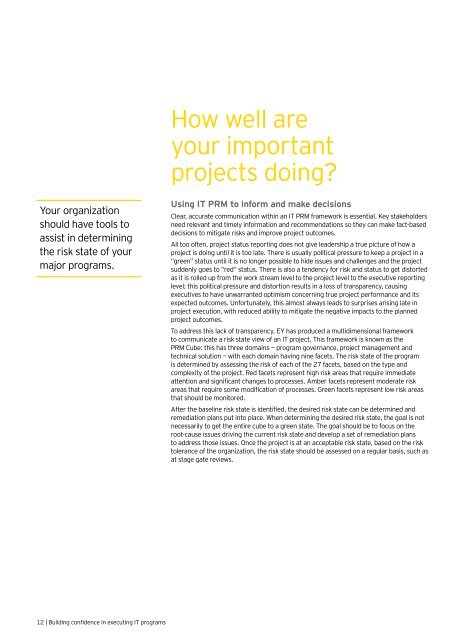Building confidence in executing IT programs
1MvMFcE
1MvMFcE
- No tags were found...
Create successful ePaper yourself
Turn your PDF publications into a flip-book with our unique Google optimized e-Paper software.
How well are<br />
your important<br />
projects do<strong>in</strong>g?<br />
Your organization<br />
should have tools to<br />
assist <strong>in</strong> determ<strong>in</strong><strong>in</strong>g<br />
the risk state of your<br />
major <strong>programs</strong>.<br />
Us<strong>in</strong>g <strong>IT</strong> PRM to <strong>in</strong>form and make decisions<br />
Clear, accurate communication with<strong>in</strong> an <strong>IT</strong> PRM framework is essential. Key stakeholders<br />
need relevant and timely <strong>in</strong>formation and recommendations so they can make fact-based<br />
decisions to mitigate risks and improve project outcomes.<br />
All too often, project status report<strong>in</strong>g does not give leadership a true picture of how a<br />
project is do<strong>in</strong>g until it is too late. There is usually political pressure to keep a project <strong>in</strong> a<br />
“green” status until it is no longer possible to hide issues and challenges and the project<br />
suddenly goes to “red” status. There is also a tendency for risk and status to get distorted<br />
as it is rolled up from the work stream level to the project level to the executive report<strong>in</strong>g<br />
level; this political pressure and distortion results <strong>in</strong> a loss of transparency, caus<strong>in</strong>g<br />
executives to have unwarranted optimism concern<strong>in</strong>g true project performance and its<br />
expected outcomes. Unfortunately, this almost always leads to surprises aris<strong>in</strong>g late <strong>in</strong><br />
project execution, with reduced ability to mitigate the negative impacts to the planned<br />
project outcomes.<br />
To address this lack of transparency, EY has produced a multidimensional framework<br />
to communicate a risk state view of an <strong>IT</strong> project. This framework is known as the<br />
PRM Cube: this has three doma<strong>in</strong>s — program governance, project management and<br />
technical solution — with each doma<strong>in</strong> hav<strong>in</strong>g n<strong>in</strong>e facets. The risk state of the program<br />
is determ<strong>in</strong>ed by assess<strong>in</strong>g the risk of each of the 27 facets, based on the type and<br />
complexity of the project. Red facets represent high risk areas that require immediate<br />
attention and significant changes to processes. Amber facets represent moderate risk<br />
areas that require some modification of processes. Green facets represent low risk areas<br />
that should be monitored.<br />
After the basel<strong>in</strong>e risk state is identified, the desired risk state can be determ<strong>in</strong>ed and<br />
remediation plans put <strong>in</strong>to place. When determ<strong>in</strong><strong>in</strong>g the desired risk state, the goal is not<br />
necessarily to get the entire cube to a green state. The goal should be to focus on the<br />
root-cause issues driv<strong>in</strong>g the current risk state and develop a set of remediation plans<br />
to address those issues. Once the project is at an acceptable risk state, based on the risk<br />
tolerance of the organization, the risk state should be assessed on a regular basis, such as<br />
at stage gate reviews.<br />
12 | <strong>Build<strong>in</strong>g</strong> <strong>confidence</strong> <strong>in</strong> execut<strong>in</strong>g <strong>IT</strong> <strong>programs</strong>



